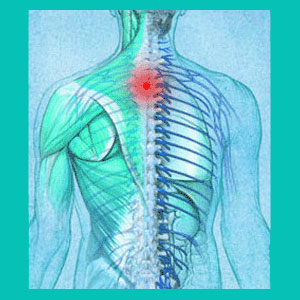
Thoracic herniated disc injury is the least common location for suffering a traumatic intervertebral event in the spinal column. The thoracic spine exists in the middle of the back and is very strong and resilient to damage. However, direct and significant trauma to this region can inflict serious injury to the spinal structures and can cause bulging or ruptured discs, as well as fractured vertebrae and muscular injuries, as well. Although thoracic herniations are the exception to the rule, they can still spell big trouble for affected patients.
This study explores the causes, effects and treatments of trauma to the spinal discs in the middle and upper back regions.
Sources of Thoracic Herniated Disc Injury
Serious thoracic disc damage is rare, but typically comes from a focused force applied suddenly and with deadly accuracy to the mid or upper back region. Motor vehicle accidents, falls and sports injuries are the most common sources of disc protrusions in the middle back. Minor middle and upper back injuries generally spare the intervertebral discs and usually only affect the soft tissues, such as muscles, ligaments and tendons. Although these scenarios can be painful, they rarely leave any lasting effects and should heal completely within days or weeks.
Lower cervical surgery is also a very common cause of upper thoracic disc abnormalities. Spinal fusion, in particular, places inordinate stresses on surrounding non-operated levels. This stress can lead to escalated and increased intervertebral degeneration, desiccation and subsequent herniation.
Thoracic Spinal Disc Injury Information
Thoracic herniated discs can be a treatment problem for many patients, since so many care providers specialize in lumbar herniated disc and herniated discs in the neck. Some back care providers never even see a truly problematic thoracic herniation for years at a time. Of course, most diagnosed herniations in the middle back are completely harmless, just like bulging discs in other spinal anatomical areas.
In the case of any thoracic herniated disc which does exist, the chance of it causing chronic pain and related neurological expressions is remote, unless the symptoms support the diagnostic theory 100%.
Thoracic Herniated Disc Injury Experiences
I have corresponded with many patients who did have actual structural issues with symptomatic bulging discs in the middle and upper back. Some were told that the discs were unlikely to be the source of pain, despite solid evidence of nerve compression, such as objective numbness and weakness, which eventually responded to appropriate treatment. Others had their intervertebral disc conditions blamed completely for pains that did not make any sense, given the diagnosis.
I advise most patients to be very wary of blaming lasting pain on a herniated disc, regardless of where it occurs in the spine, but I also caution thoracic patients to study their expected symptomology and compare it to their actual pain pattern to look for similarities and discrepancies. This is the best way to prevent misdiagnosis and achieve lasting relief from your painful complaints.
Although my own intervertebral problems involve all the discs in my cervical spine and the last 2 in my lumbar spine, I do still have 4 thoracic herniations, in the first 4 levels of my upper back, as well. It is because of this fact that I have spent even more time and effort than normal in researching the effects of these rather atypical spinal abnormalities.
Herniated Disc > Herniated Disc in the Upper Back > Thoracic Herniated Disc Injury




